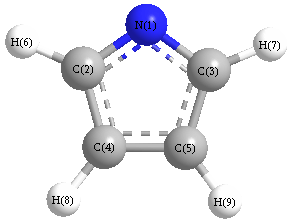Vibrational Frequencies calculated at TPSSh/6-31G*
| Mode Number |
Symmetry |
Frequency
(cm-1) |
Scaled Frequency
(cm-1) |
IR Intensities
(km mol-1) |
Raman Act
(Å4/u) |
Dep P |
Dep U |
|---|
| 1 |
A1 |
3272 |
3139 |
4.45 |
|
|
|
| 2 |
A1 |
3224 |
3093 |
5.36 |
|
|
|
| 3 |
A1 |
1578 |
1514 |
0.88 |
|
|
|
| 4 |
A1 |
1456 |
1397 |
23.14 |
|
|
|
| 5 |
A1 |
1206 |
1157 |
3.08 |
|
|
|
| 6 |
A1 |
1104 |
1060 |
36.00 |
|
|
|
| 7 |
A1 |
1056 |
1013 |
0.24 |
|
|
|
| 8 |
A1 |
868 |
833 |
11.63 |
|
|
|
| 9 |
A2 |
897 |
861 |
0.00 |
|
|
|
| 10 |
A2 |
816 |
782 |
0.00 |
|
|
|
| 11 |
A2 |
485 |
465 |
0.00 |
|
|
|
| 12 |
B1 |
825 |
792 |
1.24 |
|
|
|
| 13 |
B1 |
715 |
686 |
53.59 |
|
|
|
| 14 |
B1 |
537 |
515 |
21.28 |
|
|
|
| 15 |
B2 |
3252 |
3120 |
12.33 |
|
|
|
| 16 |
B2 |
3220 |
3090 |
26.69 |
|
|
|
| 17 |
B2 |
1371 |
1316 |
44.83 |
|
|
|
| 18 |
B2 |
1309 |
1256 |
0.01 |
|
|
|
| 19 |
B2 |
1078 |
1034 |
8.56 |
|
|
|
| 20 |
B2 |
943 |
905 |
0.05 |
|
|
|
| 21 |
B2 |
672 |
645 |
4.24 |
|
|
|
Unscaled Zero Point Vibrational Energy (zpe) 14943.3 cm
-1
Scaled (by 0.9594) Zero Point Vibrational Energy (zpe) 14336.6 cm
-1
See section
III.C.1 List or set vibrational scaling factors
to change the scale factors used here.
See section
III.C.2
Calculate a vibrational scaling factor for a given set of molecules
to determine the least squares best scaling factor.
Charges, Dipole, Quadrupole and Polarizability
Charges from optimized geometry at TPSSh/6-31G*
Charges (e)
| Number |
Element |
Mulliken |
CHELPG |
AIM |
ESP |
| 1 |
N |
-0.424 |
|
|
|
| 2 |
C |
0.045 |
|
|
|
| 3 |
C |
0.045 |
|
|
|
| 4 |
C |
-0.182 |
|
|
|
| 5 |
C |
-0.182 |
|
|
|
| 6 |
H |
0.177 |
|
|
|
| 7 |
H |
0.177 |
|
|
|
| 8 |
H |
0.172 |
|
|
|
| 9 |
H |
0.172 |
|
|
|
Electric dipole moments
Electric dipole components in Debye
(What's a Debye? See section
VII.A.3)
| |
x |
y |
z |
Total |
| |
0.000 |
0.000 |
-2.294 |
2.294 |
| CHELPG |
|
|
|
|
| AIM |
|
|
|
|
| ESP |
|
|
|
|
Electric Quadrupole moment
Quadrupole components in D Å
Polarizabilities
Components of the polarizability tensor.
Units are
Å
3 (Angstrom cubed)
Change units.
| |
x |
y |
z |
| x |
2.658 |
0.000 |
0.000 |
| y |
0.000 |
8.197 |
0.000 |
| z |
0.000 |
0.000 |
6.889 |
<r2> (average value of r
2) Å
2
| <r2> |
81.957 |
| (<r2>)1/2 |
9.053 |
